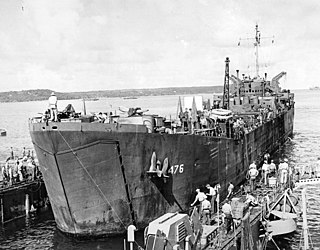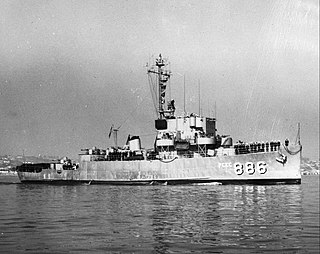
USS Cebu (ARG-6) was a Luzon-class internal combustion engine repair ship that saw service in the United States Navy during World War II. Named after Cebu, an island in the Philippines, it was the second ship of the Navy to bear this name.

USS Ampere (PCE-919/AM-359/YDG-11/ADG-11) was originally planned as a PCE-905-class patrol craft for the United States Navy, PCE-919, and laid down as an Admirable-class minesweeper, named Drake, for the male duck. Before she was commissioned, her name was cancelled and she was reclassified as a District Degaussing Vessel. She was later renamed Ampere, after the ampere, a unit of electric current, which takes its name from the French physicist André-Marie Ampère.
The third USS Magnet (ADG-9) was a degaussing vessel of the United States Navy, named after the magnet. Originally planned as a patrol craft escort (PCE-879), she was laid down on 27 May 1943 by the Albina Engine & Machine Works of Portland, Oregon; launched 30 September 1943; reclassified YDG-9 on 23 December 1943; and commissioned 10 July 1944.

USS Lodestone (ADG-8) was a degaussing vessel of the United States Navy, named after the mineral lodestone. Originally planned as a patrol craft escort (PCE-876), she was laid down on 27 May 1943 by the Albina Engine & Machine Works of Portland, Oregon; launched 30 September 1943; reclassified YDG-8 on 23 December 1943; and commissioned 10 July 1944.

USS Oceanus (ARB-2) was planned as a United States Navy LST-1-class tank landing ship, but was redesignated as one of twelve Aristaeus-class battle damage repair ships built for the United States Navy during World War II. Named for Oceanus, she was the only US Naval vessel to bear the name.

USS Oahu (ARG-5) was a Luzon-class internal combustion engine repair ship that saw service in the United States Navy during World War II. Named for the Island of Oahu, third largest island in the Hawaiian chain, it was the second US Naval vessel to bear the name.

USS Sterope (AK-96) was a Crater-class cargo ship commissioned by the U.S. Navy for service in World War II. She was responsible for delivering troops, goods and equipment to locations in the war zone.

USS Allioth (AK-109/IX-204/AVS-4) was a Crater-class cargo ship commissioned by the US Navy for service in World War II, named after Alioth, a star in constellation Ursa Major. She was responsible for delivering troops, goods and equipment to locations in the war zone.

USS Amador (AK-158) was an Alamosa-class cargo ship commissioned by the US Navy for service in World War II. She was responsible for delivering troops, goods and equipment to locations in the war zone.

SS Point Bonita was constructed in 1918 and launched 27 March 1918 after a hull being built for foreign owners at Albina Engine and Machine Works was requisitioned during World War I by the United States Shipping Board (USSB). The ship saw service as the Navy transport USS Point Bonita, assigned Identification Number 3496, from 7 October 1918 to 7 April 1919, was returned to the USSB and saw civilian service with several commercial companies as San Pedro and Oliver Olson before again seeing service in World War II as USS Camanga (AG-42). After return to commercial service as Oliver Olson the ship was wrecked at the entrance to Bandon harbor in Oregon.

USS Majaba (AG-43/IX-102) was the Design 1049 cargo ship Meriden built in 1919 by the Albina Engine & Machine Works, Portland, Oregon. All the ships were requisitioned by the United States Shipping Board (USSB) for World War I service. The ship was bought by the E. K. Wood Lumber Co., of San Francisco, California in 1923 and renamed El Capitan. The ship was chartered by the U.S. Navy through the War Shipping Administration (WSA) in April 1942 and commissioned as Majaba.

USS Besboro (AG-66) was built as Caddopeak, a United States Shipping Board (USSB) Emergency Fleet Corporation Design 1049 cargo ship built by Albina Engine & Machine Works, launched 18 October 1918. From 1922 Caddopeak served several commercial shipping companies until sold in 1937 to Burns Steamship Company and renamed Lurline Burns. On 2 February 1942 the ship was delivered to the War Shipping Administration, allocated to the United States Army and operated by Burns and Alaska Steamship Company under an Army charter agreement.

USS LST-476 was a United States Navy LST-1-class tank landing ship used in the Asiatic-Pacific Theater during World War II.

Albina Engine & Machine Works was a shipyard along the Willamette River in Portland, Oregon, United States. It was located in the Albina area of Portland along N. River Street and N. Loring Street. Albina Engine & Machine Works was founded in 1904. The shipyard produced a number of freighters during World War I, but operated mainly as a repair yard during the 1920s and 1930s. The Albina yard expanded its workforce and production during Portland's World War II shipbuilding boom. It specialized in producing subchasers, vessels designed to combat German U-boats. Albina Engine & Machine Works also built Landing Craft Support boats and cargo ships. Business declined in the post-war years, and Albina Engine & Machine Works was sold to the Dillingham Corporation around 1971.

USS Havre was a United States Navy PCE-842-class patrol craft escort in commission from 14 February 1944 to 1 July 1970. She served in the Central Pacific during World War II, supporting invasions of Battle of Iwo Jima and the Battle of Okinawa, and was present in Tokyo Bay for the formal Surrender of Japan on 2 September 1945. Unlike other ships from this class, which were scrapped or sold to other nations, the vessel stayed the property of the United States Navy, which transferred ownership to the United States Navy Reserve as Naval Reserve Training Ship for 9th Naval District (Chicago) in April 1954. She was renamed USS Havre (PCE-877) on 15 February 1956 as part of a Navy-wide initiative to provide names to all numbered ships. Havre served on the Great Lakes until struck from Navy List on 1 July 1970.

USS PCE-872 was a PCE-842-class patrol craft for the United States Navy during World War II. She was renamed Caribe after being acquired by the Cuban Navy on 1 October 1947.

USS Banning (PCE-886) was a PCE-842-class patrol craft for the United States Navy during World War II.

USS PCE-869 was a PCE-842-class patrol craft for the United States Navy during World War II. She was renamed ROCSYong Xing (PCE-42) and ROCS Wei Yuan (PCE-68) after being acquired by the Republic of China Navy on 28 August 1945.

USS PCE-867 was a PCE-842-class patrol craft for the United States Navy during World War II. She was renamed ROCSYong Tai (PCE-41) and ROCS Shan Hai (PCE-62) after being acquired by the Republic of China Navy on 7 February 1948.

USS PCE-882 was a PCE-842-class patrol craft for the United States Navy during World War II. She was renamed ROKSNoryang (PCEC-51) after being acquired by the Republic of Korea Navy on 11 February 1955.

















